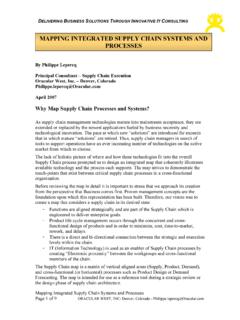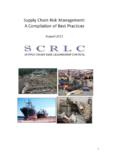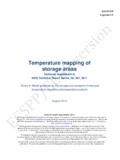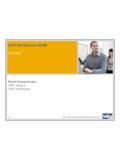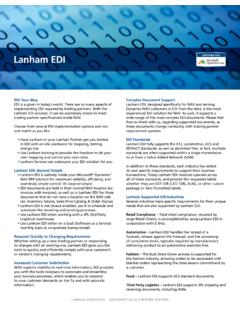Transcription of Procurement Systems Integration Within the …
1 Perspectives Spend Matters. All Rights Systems Integration Within the Enterprise: Exploring Integration In The CloudBy: Jason Busch, Managing Director, Research, Spend MattersOne of the side effects of the rising stature and role of Procurement in the past decade is that the function is no longer a purchasing silo of its own. As a result, Procurement both teams and Systems is interfacing with more Systems as it expands its role and reach across the enterprise. An essential component of this expanding charter is the need to increasingly focus on influencing, controlling and managing front-line buying and spending decisions. To be effective, however, the mission requires linking Procurement and process more tightly across all of the Systems including ERP (financials), inventory management, human resources/human capital management (HCM), vendor management Systems (VMS), customer relationship management (CRM) and other business applications.
2 Spend Matters research suggests that the rising need for connectivity and Integration between Systems touching on Procurement mirrors four current business needs that many companies are looking for from Procurement and finance organizations: Flexibility Focused on the ability to integrate new Systems quickly while adapting to the changing business environment Control Influencing and controlling spending decisions on the front lines of the business Visibility Insight into both spending activity and decisions, plus broader budgets and the ability to proactively manage cash more efficiently and effectively Forecasting Using Procurement intelligence for finance-driven forecasting, scenario building, budget building, etc. In each of these four areas (explored in significantly more detail in the business and Integration trend addendum at the end of this paper), business leaders and executives are the ones who benefit most from successful Procurement and enterprise application Integration .
3 But Integration is just as critical to enable typical employees. On the frontlines of most businesses, properly configured and enabled P2P tools are just as ubiquitous and frequented as CRM or HR Systems . More and more casual users that interact with a single system of record on a frequent basis (outside of ERP or employee benefits Systems ) are now touching on Procurement . For these employees, P2P can ideally serve as a bridge to drive greater accessibility into information contained across other Systems and likewise, can play a key role in the quality and use of data in other Systems ( , supplier/vendor master). Yet Systems Integration and visibility is a key foundational component to enable the types of outcomes that typical frontline users are after whether they want to make a basic purchase and do the right thing or have a more advanced query or action they want to take.
4 In short, for both Procurement and finance teams not to mention line-of-business users P2P and related Systems Integration has become the glue to cement better overall business strategies and, of course, successful eProcurement and e-invoicing surround Spend Matters. All Rights Integration has never been a walk in the park. In fact, one of the major reasons that so many earlier SAP, Oracle eBusiness Suite, PeopleSoft and Ariba implementations became better known for the size and frequency of the IT Integration checks that had to be written during initial deployments (and on an ongoing basis), rather than speed, finesse or spend capture, was due to the internal challenge and expense of behind-the-firewall Systems -to- Systems Integration . Today, the same challenges often remain given the degree to which companies have customized their core financials, inventory and related Systems .
5 But business leaders are expecting and demanding more. For one, companies aren t looking to spend the time it takes to play a test match (to borrow a cricket analogy) to gain early P2P Integration success. They re looking to play a Twenty20 (T20) match that can be completed in hours or days at least metaphorically. Business users should expect and demand more rapid Systems Integration than in the past. They are also focused on encouraging and enabling the right type of buying behavior rather than just acting as a policeman in a command and control system of P2P enforcement. Ultimately, Integration is about making frontline users accountable, not just compliant. For this reason, P2P integrations are impacting the front-line user buyer experience and changing the experience of the application (rather than just as a necessary byproduct of an initial roll-out).
6 Consider how finance as well as P&L owners are increasingly looking to bridge internal gaps between buy- and sell-side activities, using the visibility gained from real-time Systems Integration to gauge overall business activity and enabling balance of trade visibility with key partners when they need it versus having to wait days or weeks for the next report or spend refresh. In other situations, Procurement and finance teams want to enable visibility across Systems to drive regulatory compliance ( , meeting specific industry compliance requirements for financial services and healthcare buying tied to approved suppliers and even individuals from approved services suppliers).One of the best litmus tests we have seen in looking at how successful (and sophisticated) Procurement operations is checking out enabled P2P Integration types.
7 From examining these integrations, it is possible to not only deduce what type of industry a company is in ( , manufacturing vs. virtual goods vs. people-based) but also the risk gaps that might remain open. In the examples that follow later, we will examine specific Integration types in more detail on an industry the Evolution of Integration Strategies Exploring Typical Integration LinkagesSpend Matters observes four types of P2P integrations areas where eProcurement or other frontline buying Systems are integrated in real-time. The first (and most common) is Integration into core ERP/MRP environments focused on core financials and inventory The second is focused on Procurement related integrations into a range of toolsets. These may include vendor management Systems (VMS), software monitoring/metering/licensing applications, T&E and travel tools, contract management Systems , supplier management applications and e-invoicing/AP automation tools The third is to more generalized business applications outside of Procurement that are relatively similar across industries.
8 This can include CRM, HR, specialized inventory, warehouse management, asset management, claims/warranty and related toolsets The fourth is industry-specific, such as in retail/point-of-sale (POS) Systems . Other examples include contract management and e-invoicing capabilities necessary in environments such as oil and gas, where a $200 million PO might have a single-line item: drill an offshore well Let s explore the first area in more detail, digging into what we might call a vanilla cloud Integration scenario with a company s core financial system . We should note that no Integration is entirely vanilla, even in the case of standard ERP/MRP Integration , which often forms the connectivity between front line buying and Procurement activity and IT/finance Systems .
9 In the first area, typical fields that organizations map for integrations are often highly dependent on the specific ERP and business application packages they are integrating with. Perspectives Spend Matters. All Rights an SAP environment, for example, journal entries linked to cloud-based eProcurement transactions or a frontline buying environment that sits on top of a direct ERP Procurement system must tie to specific objects mapped in the SAP environment, including projects, orders and cost centers (GL codes are just the ante). Specific requirements may differ based on the degree of the SAP environment s customization for financial accounting, corporate governance, managerial accounting and related areas. In the case of supporting plan-driven Procurement to consolidate ordering Within core SAP ECC integrated with an external P2P system , organizations must consider not only what fields are mapped and integrated but which system relays information to suppliers (and then how supplier updates and responses are integrated back).
10 The complexity of potential P2P Integration into SAP Integration is limited only by one s imagination or specifically, the imagination of the IT and finance departments that originally deployed the system . For example, for internal cost allocations, one might opt for simple Integration based on standard fields configured Within a third-party (or ERP) eProcurement system with ties into inventory Systems . Others might opt for additional Integration fields and cross-linked postings and subsequent fields Within the P2P toolset for areas such as indirect activity allocations, material movements, overhead rates, delivery scheduling, transfer orders and related fields. The number of fields and complexity is fractal. Those that layer on an SAP APO (supply chain) or logistics/warehousing capability for either (or both) sales and demand planning can expect additional mapping requirements ( , manufacturing orders, stock movements, deconsolidation, inbound delivery tasks) in tightly coupled P2P and re-skinned front-end direct buying applications.
